Monday, September 25th 2017

Intel Core i9-7980XE 18-Core CPU @ 6.1 GHz on All Cores, Consumes up to 1000 W
Overclocker extraordinaire Der8auer has been able to put Intel's flagship, HCC HEDT 7980XE CPU, through its paces under extreme cooling, which resulted in a veritable show of force from the blue giant. Intel's $1,979, 18-core, 36-thread CPU has cemented itself as the flagship consumer CPU of choice, surpassing AMD's 1950X Threadripper in all fields. And yes, we do mean single-core and multi-core benchmarks, but also power consumption figures.
With 18 cores in need of adequate cooling, every piece of real-estate that may serve as an heatsink of sorts comes at a premium; that is why thermal paste for this Intel processor was applied not only to the CPU die itself, but also to the entire PCB around it. Der8auer says that doing this allows heat to be better dissipated form the CPU die, allowing for up to 400 MHz increased clock-speeds under load. Direct contact with the die was also tried, and achieved by cutting off the central pat of the IHS, while keeping the edges of it as a way of better load balancing the weight of the cooler (in this case, an LN2 cooler) over the CPU's PCB, in order to avoid different amounts of pressure on the CPU pins. However, the extreme overclocker ended up not recommending that venue, for it didn't offer consistent success in their extreme cooling efforts.Compared to a Ryzen Threadripper 1950X @ 5.4 GHz on all cores, under LN2, which achieved a 4514 score in Cinebench R15. Intel 7980XE @ 5.6 GHz, achieved 5635 multi-threaded and 257 single-threaded points in the same benchmark. Der8auer estimates that 24/7 stable overclocks on the Intel 7980XE would achieve around 190 points in Cinebench's single thread workloads, while a Ryzen Threadripper in the same conditions would be able to achieve between 160 and 170 points. Intel's platform clearly has the upper hand when it comes to overclocked CPU scores, though users do have to consider the platform differences between Intel's X299 and AMD's X399 platforms.A quick check of the Intel 7980XE's power consumption showed around 70 Amps being pulled through the 12 V rail (of which the majority of its power delivery goes straight to that central processing unit), which means that the CPU was pulling around 840 W power ( 70 Amps x 12 V) at a relatively safe 5.5 GHz overclock. Those wattage numbers saw increases of up to 1000 W in more radical 5.8, 6 GHz overclocks. These were achieved with a vCore of 1.45 V, which isn't really that high a value compared to historical Intel CPU overclocks - be these through extreme or more conventional cooling methods. Mindbogglingly, the Intel 7980XE was delivering temperature readings that were above 0 ºC, in a cooling loop that placed LN2 at -100 ºC in contact with the heat-spreader. This means the Intel CPU was able to surpass in heat production the -100 ºC of the LN2 cooling. Final overclocking values that successfully completed a loop of Cinebench's R15 benchmark on the multi-threaded test reached 6.1 GHz on all 18 cores, with Hyper Threading active.Making use of an NVIDIA Titan Xp graphics card ( with modded voltage values and power limit), under LN2 cooling as well, saw the card reaching 2455 MHz on the GPU core. This score stands a little conservative when compared to some GTX 1080 Ti's overclocking, which saw in excess of 2700 MHz being achieved, but the wider, beefier computing resources present on NVIDIA's flagship graphics card in terms of pure shader count meant that this Titan Xp, paired with Intel's 7980XE processor under a 5.5 GHz core clock, saw it achieving 45,705 points under 3D Mark 11, 35,782 points in Fire Strike, and 120,425 points in 3D Mark Vantage. Not too shabby for some day's work, wouldn't you say? Feel free to take a look at Der8auer's work - and video - in the below embed.
Source:
Der8auer's YouTube Channel
With 18 cores in need of adequate cooling, every piece of real-estate that may serve as an heatsink of sorts comes at a premium; that is why thermal paste for this Intel processor was applied not only to the CPU die itself, but also to the entire PCB around it. Der8auer says that doing this allows heat to be better dissipated form the CPU die, allowing for up to 400 MHz increased clock-speeds under load. Direct contact with the die was also tried, and achieved by cutting off the central pat of the IHS, while keeping the edges of it as a way of better load balancing the weight of the cooler (in this case, an LN2 cooler) over the CPU's PCB, in order to avoid different amounts of pressure on the CPU pins. However, the extreme overclocker ended up not recommending that venue, for it didn't offer consistent success in their extreme cooling efforts.Compared to a Ryzen Threadripper 1950X @ 5.4 GHz on all cores, under LN2, which achieved a 4514 score in Cinebench R15. Intel 7980XE @ 5.6 GHz, achieved 5635 multi-threaded and 257 single-threaded points in the same benchmark. Der8auer estimates that 24/7 stable overclocks on the Intel 7980XE would achieve around 190 points in Cinebench's single thread workloads, while a Ryzen Threadripper in the same conditions would be able to achieve between 160 and 170 points. Intel's platform clearly has the upper hand when it comes to overclocked CPU scores, though users do have to consider the platform differences between Intel's X299 and AMD's X399 platforms.A quick check of the Intel 7980XE's power consumption showed around 70 Amps being pulled through the 12 V rail (of which the majority of its power delivery goes straight to that central processing unit), which means that the CPU was pulling around 840 W power ( 70 Amps x 12 V) at a relatively safe 5.5 GHz overclock. Those wattage numbers saw increases of up to 1000 W in more radical 5.8, 6 GHz overclocks. These were achieved with a vCore of 1.45 V, which isn't really that high a value compared to historical Intel CPU overclocks - be these through extreme or more conventional cooling methods. Mindbogglingly, the Intel 7980XE was delivering temperature readings that were above 0 ºC, in a cooling loop that placed LN2 at -100 ºC in contact with the heat-spreader. This means the Intel CPU was able to surpass in heat production the -100 ºC of the LN2 cooling. Final overclocking values that successfully completed a loop of Cinebench's R15 benchmark on the multi-threaded test reached 6.1 GHz on all 18 cores, with Hyper Threading active.Making use of an NVIDIA Titan Xp graphics card ( with modded voltage values and power limit), under LN2 cooling as well, saw the card reaching 2455 MHz on the GPU core. This score stands a little conservative when compared to some GTX 1080 Ti's overclocking, which saw in excess of 2700 MHz being achieved, but the wider, beefier computing resources present on NVIDIA's flagship graphics card in terms of pure shader count meant that this Titan Xp, paired with Intel's 7980XE processor under a 5.5 GHz core clock, saw it achieving 45,705 points under 3D Mark 11, 35,782 points in Fire Strike, and 120,425 points in 3D Mark Vantage. Not too shabby for some day's work, wouldn't you say? Feel free to take a look at Der8auer's work - and video - in the below embed.
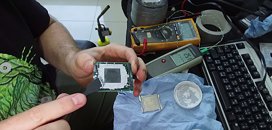
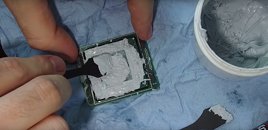

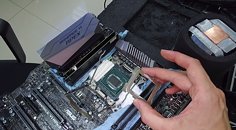


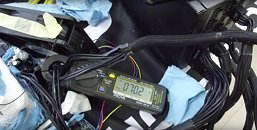

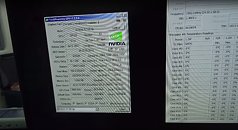



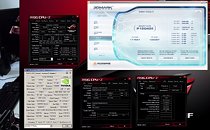
53 Comments on Intel Core i9-7980XE 18-Core CPU @ 6.1 GHz on All Cores, Consumes up to 1000 W
18 cores at 6.1GHz
damn
:eek:
6 ghz all cores is huge for benching... wow!
IOIYAI
(Its OK If You Are Ignorant)
Have you seen the 3D damage Vince has been doing with the thing?
Its been so long since i ran Vantage, looking at the Physics FPS is just mindblowing!!!
...then jumped back to the Vantage score. :)
But seriously, this is great from an enthusiast point of view... and someone's got money to burn. :laugh:
I'm certain he isn't burning his own money for that. ;)
Each 8-pin does about 44amps on the 12V line, there are two 8 pin power plugs on the mobo and then 2x2 on the 24pin ATC power cable so... plenty of distribution of power across all the cables.
there is mentining of a 1950X @ 5.4 GHz , how much power does this one consume ?
and then compensate for the 16 amd cores vs 18 intel cores.
are they close together WattWize or in a completely different ballpark?
so
Pryzen_hypothetical=18/16*Pryzen@5.4 * (5.5/5.4)
vs
Pintel@5.5=840W
I'd be seriously impressed if one could get such monsters to 4.5 GHz on all cores using only water cooling.
EDIT:
@Gasaraki
I don't think EPS uses all wires for power. Bunch of them are probably grounding and signal, just like with PCIe power cables/connectors. Which means your formula doesn't quite work there...
There's a good reason the server and mobile CPUs are clocked well below 4GHz.No, here's a different take from @Gasaraki .
You should be able to put 20 amps through each cable without any fuss. The resistance is in the ballpark of 10mOhms per metre, so you'd be looking at 3-4 watts on each cable at that kind of load. Given there are 8 cables in each direction, 80 amps would put you at 10A per cable, which would sit you at 1W per cable (1m length), 8w per direction, 16w on all the wires. 1-2% of total draw.
I'd expect you are losing more power on the molex connectors at that point. And in normal operation I'd expect your cables to be sinking heat away from the supply...
As long as you don't put them down the stuffed back of a case it will be perfectly fine.
~~~
Does anyone have Threadripper LN2 power draw numbers BTW?
But all 18 cores with ht on at 6 ghz = that is very impressive, i have reach 4.77 ghz on my i7 980x cpu cause i am limeted by my aircoolerbut that is only 6 cores. This impressive oc does also come at a price. Even with ln2 you are limited to how high you can go.
To cool this thing. The cheapest "made in china" air cooler is plenty... i think :roll:
Also, EPS connector is 4x 12V, and 4x ground. PCIe power does have signal wiring, but not CPU EPS.
I'll have an article on these CPUs soon... waiting for new PSU, unfortunately.